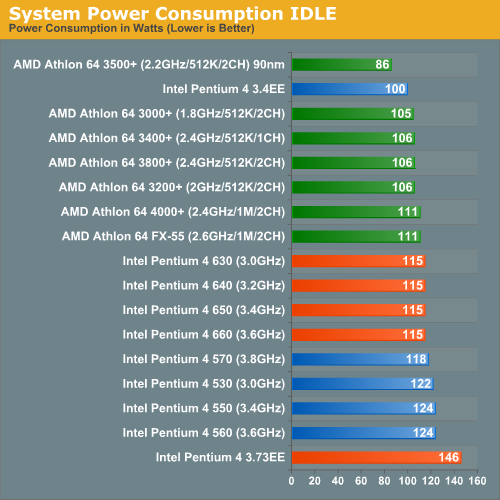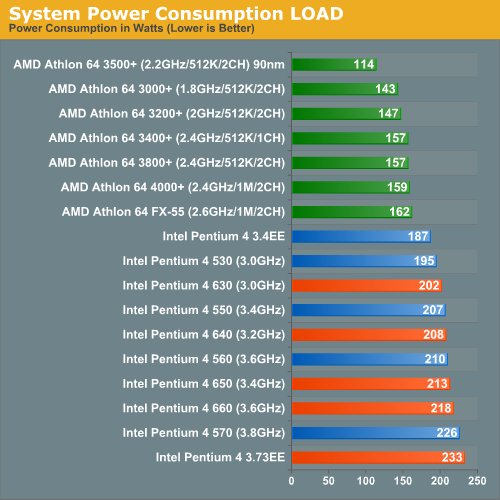Intel Pentium 4 6xx and 3.73EE: Favoring Features Over Performance
by Anand Lal Shimpi & Derek Wilson on February 21, 2005 6:15 AM EST- Posted in
- CPUs
Lower Power Consumption
Over time, any good chip manufacturer will be able to tweak and fine tune their manufacturing process to improve yields. The first 90nm Pentium 4s have been in production for over a year now, and thus it's not too far of a stretch to think that today's 90nm Pentium 4 6xx CPUs are being built on a higher yield 90nm process. In addition to normal tweaks in any manufacturing process, the new 6xx series introduces a handful of power saving techniques that help to reduce overall power consumption of the chip.
First introduced in the 5xxJ series, the Enhanced Halt State (C1E) and Thermal Monitor 2 are both mechanisms included in the 6xx series to reduce power.
Whenever the OS executes the halt instruction, the CPU enters what is known as the halt state. Architecturally what's going on in a halt state is the clock signal is shut off to the CPU for some period of time, with no clock signal none of the logic in the chip will do anything and thus power consumption is reduced. Performance is also significantly reduced, however the halt instruction isn't usually called during application usage, so the performance aspects of the halt state aren't very important.
The problem with the halt state is that it does nothing to reduce voltage, only current draw by stopping clocks from going to the CPU. Since Power varies linearly with both current and voltage (P = I * V), you're effectively only addressing half of the problem. The Enhanced Halt State, as Intel calls it, does two things - it reduces the clock speed of the CPU by decreasing the clock multiplier down to its minimum value (on the 6xx series that's 14x, or 2.8GHz) then reducing the voltage. The clock speed is reduced and then the voltage is dropped, to maintain stability.
Intel insists that the enhanced halt state is a significantly lower power state than the conventional halt state, thanks to the reduction in voltage in addition to the reduction in clock speed. While the standard halt state causes a linear reduction in power, Intel's enhanced halt state causes an exponential decrease in power, potentially offering better power savings than the standard halt state. The real world impact obviously depends on how idle your system happens to be.
When the Pentium 4 was first launched there was a lot of bad journalism out there about how it would overheat and reduce its clock speed significantly thanks its integrated Thermal Monitor. If the Pentium 4 sensed that it was operating outside of safe temperatures, its Thermal Monitor can reduce the effective clock speed of the CPU by approximately 50% - once again by cutting clocks to the CPU. In reality, the Pentium 4's clock throttling never actually came into play unless your fan stopped, or your heatsink fell off. More recent Pentium 4s however have been pushing the thermal envelope further and further, finally to the point where throttling can be a problem if you don't use high quality thermal compound and make sure your heatsink is absolutely secure. The performance reduction when the processor throttles is usually pretty significant.
With the new 6xx series of CPUs, Intel introduces Thermal Monitor 2 (TM2) which, as in the case of the enhanced halt state, reduces clock speed (to 2.8GHz) and voltage as well. The performance impact due to TM2 is much less than the original implementation, so it can actually be triggered during normal use without an overly noticeable loss of performance. However if reducing the clock speed and voltage isn't enough, the CPU will still shut itself down in order to avoid any damage just like the other Pentium 4s did.

Yes, we ran Windows Media Encoder 9 with the fan off for 5 minutes.
But both the Enhanced Halt State and TM2 were introduced in the 5xxJ CPUs, what's new to the 6xx series is the Enhanced Intel SpeedStep Technology (EIST). What EIST does is very similar to AMD's Cool'n'Quiet, it is demand based reduction in CPU clock speed and voltage. Using the same mechanism of adjusting clock speed and voltage, based on the application demand, the Pentium 4 6xx will dynamically increase/decrease its clock speed between 2.8GHz and its normal operating frequency, as well as voltage, in order to optimize for power consumption.
Because of the way EIST (and AMD's Cool'n'Quiet) works, there's inherently a drop in performance. The idea is this - if you're performing a task that's not using 100% of the CPU, the CPU will operate at a slightly reduced frequency in order to conserve power. So while some tasks will require that the system run at full speed, others will run at speeds as low as 2.8GHz. With a minimum multiplier of 14x, slower Pentium 4 6xx CPUs won't get a huge benefit from EIST. For example, the Pentium 4 630 runs at 3.0GHz, meaning the drop down to 2.8GHz isn't really going to conserve a ton of power, nor decrease performance all that much.
AMD's Cool'n'Quiet appears to be more flexible, as it can reduce the clock speed all the way down to 800MHz.
How much of a performance impact does EIST result in? Using a 100% load test such as Windows Media Encoder wouldn't tell us much, as EIST would never really kick in. But something like Winstone where the CPU load is varied, is a much better indication - without EIST, the Pentium 4 660 was approximately 5% faster in Business Winstone than with EIST enabled. Under Doom 3, there was no performance difference.


Intel Officially Adds 64-bit
The Pentium 4 600 series and 3.73EE officially enables Intel's 64-bit extensions to x86 (EM64T, Intel's version of AMD's x86-64). We will have a full look at the 64-bit performance of both AMD and Intel's implementations as soon as Microsoft Windows XP x64 is released.










71 Comments
View All Comments
DerekWilson - Monday, February 21, 2005 - link
I noticed a comment about our power numbers showing the 6xx series drawing more at load than the 5xx series ...This may be due to the fact that we ran our LOAD power test without EIST and the IDLE power was measured with EIST to get close to the min and max numbers.
Our AMD parts, however, were measured at min and max without powernow! ... so the AMD parts have the potential to post numbers even lower.
danidentity - Monday, February 21, 2005 - link
#48 - Power consumption is not going to change depending on whether you're running 64-bit apps or not.Live - Monday, February 21, 2005 - link
Nice and clean review. Good work. Tough it is not really what you want to read when the biggest CPU maker in the world releases a whole new series. Boring and utterly disappointing.Viditor - Monday, February 21, 2005 - link
Nice job AT! I appreciate very much the power consumption numbers!Request:
When we do finally get 64bit benches, I would very much like to see the power consumption figures under 64bit...
Viditor - Monday, February 21, 2005 - link
neogodless - "I would like to see more "multi-tasking" benchmarks"If it makes you feel better, many of the benches used are designed for hyperthreading...
Zebo - Monday, February 21, 2005 - link
A pig with a bowtie is still a pig. This was an arse whippin by AMD.bobsmith1492 - Monday, February 21, 2005 - link
44 - ???My XP 2.4 runs MMJB, UD Agent, about 10 IE and Mozilla windows, Word, Excel, and Paint, with a game minimized in the background, while chatting with several people on Trillian smooth as silk.
neogodless - Monday, February 21, 2005 - link
Every time I see AMD vs Intel benchmarks, I think it's great that I have an AMD at home. But then I remember how much I like using my Intel at work. The reason I bring this is up is because I would like to see more "multi-tasking" benchmarks, like running these same benchmarks with programs running the background, such as Outlook/Thunderbird, AIM/GAIM/Trillian, MusicMatch/WinAmp, and so forth.Houdani - Monday, February 21, 2005 - link
In Soviet Russia, benches mark YOU!Billy Idol - Monday, February 21, 2005 - link